
The xylophone is a musical instrument in the percussion family that consists of wooden bars struck by mallets. Like the glockenspiel, the xylophone essentially consists of a set of tuned wooden keys arranged in the fashion of the keyboard of a piano. Each bar is an idiophone tuned to a pitch of a musical scale, whether pentatonic or heptatonic in the case of many African and Asian instruments, diatonic in many western children's instruments, or chromatic for orchestral use.
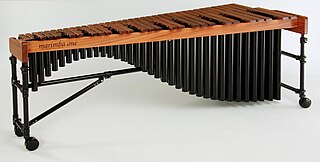
The marimba, is a musical instrument in the percussion family that consists of wooden bars that are struck by mallets. Below each bar is a resonator pipe that amplifies particular harmonics of its sound. Compared to the xylophone, the marimba has a lower range. Typically, the bars of a marimba are arranged chromatically, like the keys of a piano. The marimba is a type of idiophone.

Mbira are a family of musical instruments, traditional to the Shona people of Zimbabwe. They consist of a wooden board with attached staggered metal tines, played by holding the instrument in the hands and plucking the tines with the thumbs, the right forefinger, and sometimes the left forefinger. Musicologists classify it as a lamellaphone, part of the plucked idiophone family of musical instruments. In Eastern and Southern Africa, there are many kinds of mbira, often accompanied by the hosho, a percussion instrument. It is often an important instrument played at religious ceremonies, weddings, and other social gatherings. The "Art of crafting and playing Mbira/Sansi, the finger-plucking traditional musical instrument in Malawi and Zimbabwe" was added to the UNESCO Representative List of the Intangible Cultural Heritage of Humanity in 2020.
Hornbostel–Sachs or Sachs–Hornbostel is a system of musical instrument classification devised by Erich Moritz von Hornbostel and Curt Sachs, and first published in the Zeitschrift für Ethnologie in 1914. An English translation was published in the Galpin Society Journal in 1961. It is the most widely used system for classifying musical instruments by ethnomusicologists and organologists. The system was updated in 2011 as part of the work of the Musical Instrument Museums Online (MIMO) Project.

A resonator is a device or system that exhibits resonance or resonant behavior. That is, it naturally oscillates with greater amplitude at some frequencies, called resonant frequencies, than at other frequencies. The oscillations in a resonator can be either electromagnetic or mechanical. Resonators are used to either generate waves of specific frequencies or to select specific frequencies from a signal. Musical instruments use acoustic resonators that produce sound waves of specific tones. Another example is quartz crystals used in electronic devices such as radio transmitters and quartz watches to produce oscillations of very precise frequency.
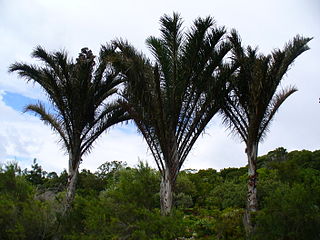
Raffia palms are a genus of about twenty species of palms native to tropical regions of Africa, and especially Madagascar, with one species also occurring in Central and South America. R. taedigera is the source of raffia fibers, which are the veins of the leaves, and this species produces a fruit called "brazilia pods", "uxi nuts" or "uxi pods".
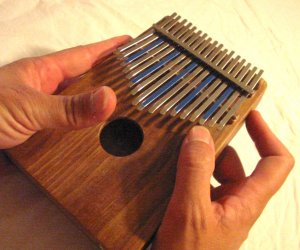
A lamellophone is a member of the family of musical instruments that makes its sound by a thin vibrating plate called a lamella or tongue, which is fixed at one end and has the other end free. When the musician depresses the free end of a plate with a finger or fingernail, and then allows the finger to slip off, the released plate vibrates. An instrument may have a single tongue or a series of multiple tongues.
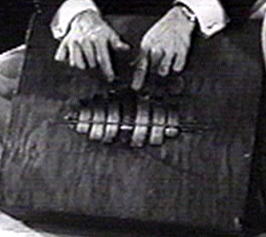
The marímbula is a plucked box musical instrument of the Caribbean. In Cuba it is common in the changüí genre, as well as old styles of son. In Mexico, where it is known as marimbol is played in son jarocho; in the Dominican Republic, where it is known as marimba, it is played in merengue típico, and in Jamaica it is known as rumba box and played in mento.

The rebab is the name of several related string instruments that independently spread via Islamic trading routes over much of North Africa, Middle East, Central Asia, Southeast Asia, and parts of Europe. The instrument is typically bowed, but is sometimes plucked. It is one of the earliest known bowed instruments, named no later than the 8th century, and is the parent of many bowed and stringed instruments.
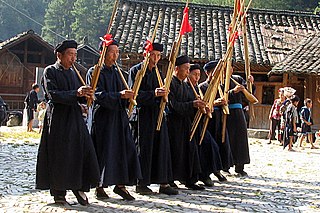
The lusheng is a Hmong musical instrument. It has a long history of 3000 years in China, traced back to the Tang Dynasty. It is a mouth organ with multiple bamboo pipes, each fitted with a free reed, which are fitted into a long blowing tube made of hardwood. It most often has five or six pipes of different pitches and is thus a polyphonic instrument. Its construction includes six parts. It comes in sizes ranging from very small to several meters in length.

Kolintang is a traditional Minahasan percussion instrument from North Sulawesi, Indonesia, consisting of wooden blades arranged in a row and mounted on a wooden tub. Kolintang is usually played in ensemble music. Kolintang in the Minahasan community is used to accompany traditional ceremonies, dance, singing, and music. The wood used to make Kolintang blades is light but strong local wood such as Telur wood, Wenuang wood, Cempaka wood, Waru wood, and the like which have a fiber construction. parallel. Meanwhile, kolintang resonator crates are usually made of hardwood materials such as teak or mahogany.

The Kuba Kingdom, also known as the Kingdom of the Bakuba or Bushongo, is a traditional kingdom in Central Africa. The Kuba Kingdom flourished between the 17th and 19th centuries in the region bordered by the Sankuru, Lulua, and Kasai rivers in the heart of the modern-day Democratic Republic of the Congo.
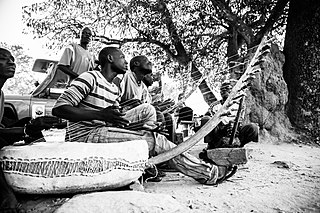
African Harps, particularly arched or "bow" harps, are found in several Sub-Saharan African music traditions, particularly in the north-east. Used from early times in Africa, they resemble the form of harps in ancient Egypt with a vaulted body of wood, parchment faced, and a neck, perpendicular to the resonant face, on which the strings are wound.

Kuba art comprises a diverse array of media, much of which was created for the courts of chiefs and kings of the Kuba Kingdom. Such work often featured decorations, incorporating cowrie shells and animal skins as symbols of wealth, prestige and power. Masks are also important to the Kuba. They are used both in the rituals of the court and in the initiation of boys into adulthood, as well as at funerals. The Kuba produce embroidered raffia textiles which in the past was made for adornment, woven currency, or as tributary goods for funerals and other seminal occasions. The wealth and power of the court system allowed the Kuba to develop a class of professional artisans who worked primarily for the courts but also produced objects of high quality for other individuals of high status.

The mvet or mvett is a stringed musical instrument, a type of stick zither, Hornbostel-Sachs (311) of the Fang people of Gabon, Cameroon, Democratic Republic of the Congo, São Tomé and Equatorial Guinea. Somewhat resembling the Mande kora, but larger and simpler, it consists of a tubular stick of palm-raffia or bamboo, between one and two metres long, with usually three calabash resonators. A central vertical bridge divides four or five gut or metal strings, played both sides of the bridge.

The seperewa, also known as seprewa or sanku, is a Ghanaian harp-lute, similar to the Dagaare/Sisaala koriduo, the Mandé kora, the Gere duu, and Baoule aloko.
Yoke lutes, commonly called lyres, are a class of string instruments, subfamily of lutes, indicated with the code 321.2 in the Hornbostel–Sachs classification.















